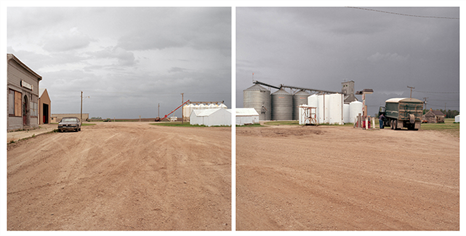Overview
Histories of American art have largely ignored the Midwest, except to describe it through a small group of painters of the 1930s. This international research collaboration aims to redress the balance. It analyses the ways in which the cultural, social, and political connotations of the American Midwest has profoundly shaped American art production, reception, and history.
Our research investigates the development in cultural histories and criticism of the paradox of the Midwest as geographical centre but cultural periphery, perceived in both popular and critical discourse as at once symbolic heartland and cultural desert. We interrogate these assumptions, exploring role of regionalist and place-making narratives in constructing artistic hierarchies and in shaping critical discourse. And we explore the work of artists who themselves addressed issues related to the Midwest as a place, a space, and an idea.

Jeff Brouws, Grain Elevators, Stanley, North Dakota, 2009. Courtesy of the artist.
Research topics include:
- the use and history of regionalist terms in art history and criticism
- a “Midwestern diaspora” in art and visual culture
- histories of Midwestern cultural place-making and Boosterism
- the Midwest as cultural metaphor
International visiting fellow profiles
In 2014, three members of the project team were in residence at the University of Nottingham under the Fulbright Visiting Fellowship scheme and the International Office Visiting Fellowship Scheme.
Professor Joni L Kinsey (University of Iowa): Kinsey focuses her research on 19th-century landscape painting and western art.
She is the author of four books, Thomas Moran and the Surveying of the American West (Smithsonian Institution Press, 1992); Plain Pictures: Images of the American Prairie (Smithsonian Institution Press, 1996); The Majestic Grand Canyon: 150 Years in Art (First Glance Books, 1998), and most recently Thomas Moran's West: Chromolithography, High Art, and Popular Taste (University Press of Kansas, 2006). Recent articles include: "Cultivating Iowa: An Introduction to Grant Wood," in Grant Wood’s Studio: Birthplace of American Gothic, edited by Jane Milosch, with Wanda Corn and James M. Dennis. Prestel Publishing, 2005); and "I Wished for the Pencil of Salvator Rosa: The Artistic Legacy of Lewis and Clark" in Finding Lewis and Clark: Old Trails, New Directions, edited by James Ronda and Nancy Tystad Koupal (Pierre: South Dakota Historical Society Press, 2004). Professor Kinsey is also the curator of the Eve Drewelowe Collection, a remarkable corpus of hundreds of paintings, sculptures, works on paper, and personal effects of Iowan painter Eve Drewelowe, who bequeathed the collection to the School of Art and Art History in the late 1980s. Kinsey was a Fulbright Visiting Fellow to the University of Nottingham in spring 2014.
Dr Corey Dzenko (University of North Carolina, Greensboro): Dzenko’s current project analyses South Korean-born, New York City-based Nikki S Lee's The Ohio Project (1999)
Dzenko considers how the artist's representations of white Ohioans replicate dominant U.S. ideals of identity--not those of "post-identity" as the artist's performances are often positioned, but those created through the relational constructions of race, class, gender, sexuality, and place. This case study forms one chapter of Dzenko's current book project in which she argues that, despite all of the recent attention paid to “identity” in art history, “mainstream” ideals of “normativity” have yet to be fully analysed as subject positions from which artistic examinations begin. To counter this gap in art historical scholarship and larger U.S. culture, Dzenko draws from a range of critical theories as she examines contemporary constructed photographs by Lee as well as Suzanne Opton, Gregory Crewdson, and Kerry Skarbakka. In the fall of 2014, Dzenko joined the faculty at Monmouth University as an Assistant Professor of Art History.
Dr Emily Burns (Auburn University): Burns is working on a book project on the visual culture of the American West in the French Imagination in the late nineteenth and early twentieth centuries.
Her research has uncovered a preference in many French sources for the landscapes more typically associated with the American Midwest, such as the prairie and the Plains Indians, than with the mountainous far West. This summer, she will be working on parsing out cultural discourses around the Midwest for French artists and filmmakers, Oglala Lakota performers travelling with Buffalo Bill's Wild West, and American artists working in Paris.